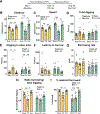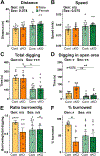Digging behavior discrimination test to probe burrowing and exploratory digging in male and female mice
- PMID: 34048600
- PMCID: PMC9066774
- DOI: 10.1002/jnr.24857
Digging behavior discrimination test to probe burrowing and exploratory digging in male and female mice
Abstract
Digging behavior is often used to test motor function and repetitive behaviors in mice. Different digging paradigms have been developed for behaviors related to anxiety and compulsion in mouse lines generated to recapitulate genetic mutations leading to psychiatric and neurological disorders. However, the interpretation of these tests has been confounded by the difficulty of determining the motivation behind digging in mice. Digging is a naturalistic mouse behavior that can be focused toward different goals, that is foraging for food, burrowing for shelter, burying objects, or even for recreation as has been shown for dogs, ferrets, and human children. However, the interpretation of results from current testing protocols assumes the motivation behind the behavior often concluding that increased digging is a repetitive or compulsive behavior. We asked whether providing a choice between different types of digging activities would increase sensitivity to assess digging motivation. Here, we present a test to distinguish between burrowing and exploratory digging in mice. We found that mice prefer burrowing when the option is available. When food restriction was used to promote a switch from burrowing to exploration, males readily switched from burrowing to digging outside, while females did not. In addition, when we tested a model of intellectual disability and autism spectrum disorder that had shown inconsistent results in the marble burying test, the Cc2d1a conditional knockout mouse, we found greatly reduced burrowing only in males. Our findings indicate that digging is a nuanced motivated behavior and suggest that male and female rodents may perform it differently.
Keywords: RRID:IMSR_CRL:27; RRID:IMSR_JAX:005359; RRID:IMSR_TAC:b6; RRID:MGI:5449582; behavioral analysis; burrowing; digging; repetitive behaviors.
© 2021 Wiley Periodicals LLC.
Conflict of interest statement
Conflict of Interest Statement
The authors declare no conflicts of interest.
Figures




Similar articles
-
Marble burying reflects a repetitive and perseverative behavior more than novelty-induced anxiety.Psychopharmacology (Berl). 2009 Jun;204(2):361-73. doi: 10.1007/s00213-009-1466-y. Epub 2009 Feb 3. Psychopharmacology (Berl). 2009. PMID: 19189082 Free PMC article.
-
Transcriptomic analysis of the hippocampus from six inbred strains of mice suggests a basis for sex-specific susceptibility and severity of neurological disorders.J Comp Neurol. 2016 Sep 1;524(13):2696-710. doi: 10.1002/cne.23989. Epub 2016 Mar 29. J Comp Neurol. 2016. PMID: 26917114
-
X11-like protein deficiency is associated with impaired conflict resolution in mice.J Neurosci. 2009 May 6;29(18):5884-96. doi: 10.1523/JNEUROSCI.5756-08.2009. J Neurosci. 2009. PMID: 19420255 Free PMC article.
-
Analysis of the marble burying response: marbles serve to measure digging rather than evoke burying.Behav Pharmacol. 1995 Jan;6(1):24-31. Behav Pharmacol. 1995. PMID: 11224308
-
Burrowing and nest building behavior as indicators of well-being in mice.J Neurosci Methods. 2014 Aug 30;234:139-46. doi: 10.1016/j.jneumeth.2014.02.001. Epub 2014 Feb 10. J Neurosci Methods. 2014. PMID: 24525328 Review.
Cited by
-
Function of orexin-1 receptor signaling in the olfactory tubercle in odor-guided attraction and aversion.Commun Biol. 2024 Dec 26;7(1):1702. doi: 10.1038/s42003-024-07438-1. Commun Biol. 2024. PMID: 39725686 Free PMC article.
-
Paternal early life stress exerts intergenerational effects on male C57Bl/6J offspring risk-taking behaviors and predator scent-induced c-Fos expression.Neuronal Signal. 2023 Apr 28;7(2):NS20220097. doi: 10.1042/NS20220097. eCollection 2023 Jul. Neuronal Signal. 2023. PMID: 37152245 Free PMC article.
-
Differential behavior responses and genetic alteration underpinning exercise effectiveness in stress-susceptible mice.Sci Rep. 2025 Apr 28;15(1):14818. doi: 10.1038/s41598-025-98630-8. Sci Rep. 2025. PMID: 40295575 Free PMC article.
-
Norepinephrine and dopamine contribute to distinct repetitive behaviors induced by novel odorant stress in male and female mice.Horm Behav. 2022 Aug;144:105205. doi: 10.1016/j.yhbeh.2022.105205. Epub 2022 Jun 1. Horm Behav. 2022. PMID: 35660247 Free PMC article.
-
Psychedelics for the Treatment of Obsessive-Compulsive Disorder: Efficacy and Proposed Mechanisms.Int J Neuropsychopharmacol. 2024 Dec 1;27(12):pyae057. doi: 10.1093/ijnp/pyae057. Int J Neuropsychopharmacol. 2024. PMID: 39611453 Free PMC article. Review.
References
-
- American Psychiatric Association. (2013). Diagnostic and Statistical Manual of Mental Disorders (Fifth Edition). American Psychiatric Association.
-
- Avenant NL, & Smith VR (2003). The microenvironment of house mice on Marion Island (sub-Antarctic). Polar Biology, 26(2), 129–141.
MeSH terms
Grants and funding
LinkOut - more resources
Full Text Sources
Other Literature Sources
Molecular Biology Databases

